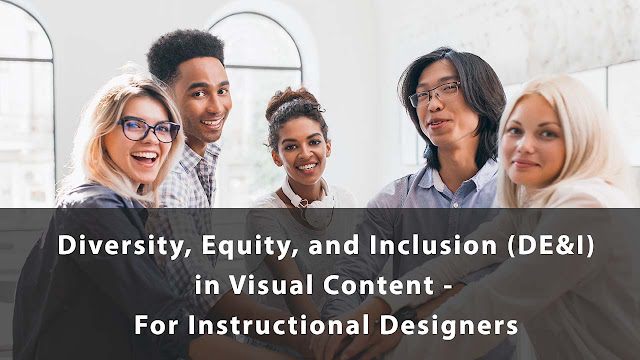Diversity, Equity, and Inclusion (DEI) in Visual Content - For Instructional Designers
The DE&I guideline is intended for all Media Teams and Content Development Partners producing visual content with respect to diversity, equity, and inclusion (DEI) for its visual content.
Watch as video
The visual content we produce should represent diversity, and it is to be
used in a way that supports the organization’s aim, without prejudice or bias.
In practice, this means that the imagery reflects the gender and ethnic
diversity, as well as differences in age and ability, with no single ethnicity
or gender dominating, and no offensive stereotypes presented. To achieve this,
we must consider, apply and question Diversity & Inclusion throughout the
visualization process about:
- Balanced representation of minorities in leadership
roles, promoting exemplary characteristics and behaviors
- Visual concepts that facilitate a balanced
representation of diverse characters, traits, and behaviors
- Design strategies that mitigate the risk of
non-contextual misrepresentation
General approaches
to DEI in Visual Content
- Avoid the tendency to depict people of color in
"problem" roles and Caucasian characters as problem solvers.
- Who is communicating the instruction in the course?
Does the educator/instructor reflect the diversity of the world? In the
past, there has been a tendency to have Caucasian
instructors/narrators/educators delivering instruction.
- Avoid negative stereotypes, such as older Caucasian
bosses, angry black characters, and female characters who are regularly
depicted as weak or submissive.
- Embrace gender and ethnic diversity in depictions of
managers, bosses, experts, and coaches. If possible, when negative
behaviors need to be portrayed display more than one character exhibiting
this behavior, and try to have an ethnic mix where multiple characters are
onscreen representing something negative.
- Similarly, ensure that minorities are included when
representing or modeling positive behaviors and roles.
- Review all proposed scenes bearing in mind how the
image would be received if taken out of context. For example, if a
screengrab of an image was circulated on Twitter how would it be likely to
be received? If you feel that a concept you are proposing would create an
image that could seem problematic if taken out of context, and may
generate offense, then you need to revise the image/concept to eliminate
that possibility. If revisions don't remove this problem, then replace the
concept with one that does not have the potential to give offense.
- Consider how a scene may be interpreted, and how
characters are positioned when developing a concept, i.e. a boss standing
berating an employee who is seated at a desk, risks creating a sense of a
real power imbalance with the standing figure seeming very dominant,
whereas both standings afford a better sense of balance.
- Consider, how facial expressions and body language may
be interpreted. There can be a real difference between a victim with a
neutral expression facing a protagonist, vs a victim with a sad/distressed
expression facing the protagonist. The latter can again create a sense of
a real power imbalance.








Post a Comment